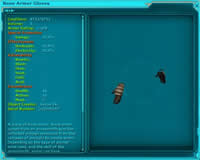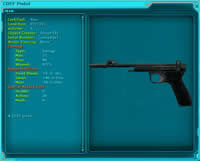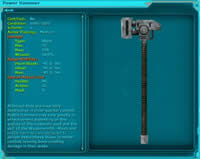Armor
Fundamentals:
Part I - Armor Attributes
There are six different sets of attributes that make up a given piece of
armor: Condition, Armor Rating, Effectiveness, Special Protection,
Vulnerability, and Encumbrance. Let's go through each of these using these
freshly crafted bone gloves (fig. 1) as an example.
 (fig. 1)
(fig. 1)
Condition:
Condition is a measure of how much damage the armor can absorb before
becoming useless. It is expressed as two numbers, the current value and the
maximum value. In our example, the bone gloves are in perfect condition with
each being at 8722. The amount of damage taken is equal to the damage that
penetrates its defenses. Therefore, if the armor absorbs 30 points from a
100-point shot, it takes 70 points of damage. Once at 0 condition, the armor
no longer provides protection. An armor repair tool can be used to restore
condition at the cost of lowering the armor's maximum.
Armor Rating:
Our bone gloves have an Armor Rating of Light. Armor Ratings have four
possible values: None, Light, Medium, and Heavy. Personal armor always falls
into the Light category with None being reserved for those with no armor and
the other two values being reserved for armored vehicles and especially
nasty critters.
Armor Rating expresses the minimum Armor Piercing value of a weapon
needed for the weapon to do its full damage. If the armor's Armor Rating is
equal to the weapon's Armor Piercing, there is no effect. If the Armor
Rating is higher, however, there is a 50% reduction for each level
difference. Therefore for the bone gloves against this CDEF Pistol's Armor
Rating of None (fig. 2), damage is reduced by 50% off of the top. But in the
case of the Power Hammer (fig. 3), its Armor Piercing is higher than the
Armor Rating. It therefore does 25% more damage. Note that the 50% reduction
or 25% increase occurs for each level. So if that CDEF were to be used
against an AT-ST whose Armor Rating is Heavy, there would be a three level
difference. So damage would be reduced by 50%, then another 50%, and another
50% for merely 12.5% of the initial damage.
 (fig. 2)
(fig. 2)
 (fig. 3)
(fig. 3)
Effectiveness:
Effectiveness measures the percent damage the armor absorbs against any
damage type in which it does not have a Vulnerability or Special Protection
(we'll get to those attributes in a bit). In this case, our Effectiveness is
15%. Don't be confused by the listing of multiple damage types under this
section in the examination UI. All values here reflect the current
Effectiveness value. They are listed verbosely to make it clear that
Effectiveness protects against all damage types not listed as
Vulnerabilities or Special Protections. The damage reduced by Effectiveness
occurs after adjustments are made due to Armor Rating.
Special Protection:
Special Protections are values that override the Effectiveness. In our
case, the armor has a Special Protection of 27% against Energy. This means
that whenever the armor is hit by Energy damage, it uses the 27% value
instead of the Effectiveness of 15%. Although Special Protections are
usually higher than the armor's Effectiveness, they can potentially be
lower. In that case, the armor would actually be weaker against that Damage
Type.
Vulnerability:
Vulnerability denotes Damage Types in which the armor offers no
protection whatsoever. Our bone armor has quite a few of these: Kinetic,
Blast, Stun, Heat, Cold, and Acid. Whenever the armor is hit by one of these
Damage Types, all of the damage goes through. The target wearing this armor
would also have an Armor Rating of None against any of these
Vulnerabilities.
Encumbrance:
Encumbrance is a measure in the reduction of statistics when the armor is
worn. The reduction occurs only in the secondary stats and not the pools.
This means that the bone gloves Health Encumbrance of 11 would reduce
Strength and Constitution by 11 points. If the Encumbrance is such that it
would ever reduce a stat below 1, the armor may not be worn.
Part II - Examples of Armor Attributes in Action
Our bone gloves are struck by the CDEF pistol for 30 base points of damage.
Because the weapon causes Energy damage, which is not one of the armor's
vulnerabilities, its protections apply. An Armor Rating of Light vs. an Armor
Piercing of None results in a 50% reduction, dropping damage down to 15. The
bone gloves have a Special Protection vs. Energy, so we use that resulting in
a reduction of 27% of the 15 remaining or 11 points. Since 11 points of damage
made it through, the armor's current Condition drops to 8711 with the maximum
Condition staying at 8722.
Our bone gloves are struck by the power hammer for 200 base points of
damage. The power hammer does blast damage which is a Vulnerability. As a
result, the bone gloves offer no protection. Armor Rating of None vs. Armor
Piercing of Medium results in 25% more damage (200 x 1.25 = 250) and then
another 25% more damage (250 x 1.25 = 312). All of the damage goes through
doing reducing the armor's current Condition by 312 to 8410.
Part III - Damage Types
Not all Damage Types are created equal. Some Damage Types are far more
common to encounter than others and armors as a whole tend to fare better or
worse against certain Damage Types. While there's no steadfast rule for this,
here are some general trends. These tend to apply to both players as well as
creatures.
Kinetic:
Kinetic is most common form of melee damage. Most armor (both player and
creature) offers at least some protection against this; some armor protects
against this greatly. Kinetic damage from ranged attacks is limited to a few
projectile weapons.
Energy:
Energy is the most common form of ranged damage. Most blasters use this
type. Like Kinetic, most armor protects against this in some manner. With
the exception of the lightsaber, melee weapons do not do Energy damage.
Blast:
Blast is used mostly by area of effect attacks. Still fairly common, most
armor offers at least some protection against this.
Elemental:
Elemental Damage Types include Heat, Cold, Electrical, and Acid. Only a
handful of attacks cause these damages and most armor has one or more
vulnerabilities to them (with Electrical and Acid Vulnerabilities being
somewhat more common).
Stun:
Stun damage is the bane of armor, player and creature alike. Most armor
is vulnerable to this Damage Type.
Armor FAQ:
Is bone armor with 20% energy better than composite with 5% energy?
Protection ratings are absolutes. A higher value is a higher value. Their
meanings don't change based on the armor type. So in this case, the bone is
better against energy. Although the maximum potential protection for composite
is higher than bone, it is possible for lighter superbly made armor to protect
better than a poorly made heavy one.
I tried on some high level armor, and it had encumbrances so high, I
couldn't wear it. Will I never be able to use that type of armor?
Depending on the materials used and the skill of the smith, armor can have
better or worse stats, and higher or lower encumbrances. That encumbrance can be
further lowered by a slicer. If you shop around, you may find lower encumbrance
armor that you're able to wear, or get a slicer to slice your existing armor.
Also, stat-boosting food, spice, and medicine can allow you wear
high-encumbrance armor.
Is it a good idea to wear my armor all the time?
Not if you do non-combat things that use Health, Action or Mind. The
encumbrances lower your secondary attributes, thereby decreasing your
regeneration rate and increase the cost for using abilities.
Do Personal Shield generators work the same as armor?
The attributes work the same as armor. There are some differences, however.
Shields have no encumbrance penalties and act as a second layer of armor. Damage
is first absorbed by the shield and whatever remains goes to the armor. Shields
also have an innate protection again Stun damage which no other crafted armor
has. The trade off, however, is that shields are extremely fragile. They wear
out quickly, making it an expensive proposition to use them continuously.
What species have restrictions to wearing armor?
Armor is technically clothing so it follows the same rules (Trandoshans can't
wear boots, Wookiees can't wear much...)


